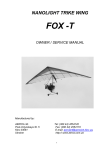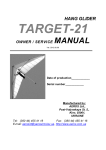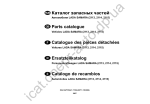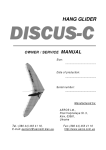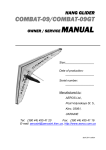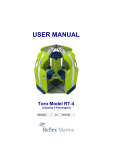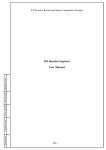Download Fox Owner / Service Manual
Transcript
HANG GLIDER FOX OWNER / SERVICE MANUAL Manufactured by: AEROS Ltd. Post-Volynskaya St. 5 Kiev 03061 Ukraine Tel: (380 44) 4554120 Fax: (380 44) 4554116 E-mail: [email protected], http:// www.aeros.com.ua 1 2 Table of Contents Technical Information and Operating Limitations .......................................................... 5 Fox Reassembly After Shipping Procedure……………………………………................ 5 Fox Breakdown For Shipping Procedure…………………......………………………........ 6 Fox Set-Up Procedure ................................................................................................... 7 Preflight Procedure…………………………………………………………………………… 11 Laying the Glider Down Flat…………………………………………………………………. 13 Launching and Flying the Fox ........................................................................................ 13 Speed to Fly ..………………………………………………………………………………….. 13 Aerotowing ..……………………………………………………………………………………. 14 Landing the Fox .............................................................................................................. 14 Fox Breakdown .......................................................................................................... .… 15 Glider Tuning …………………………………………………………………………………… 16 Maintenance.……………………………………………………………………………………. 17 In Closing - A Few Final Words on Your Safety................................................................ 19 Schemes…………………………………………................................................................. 20 3 Thank you for purchasing an Aeros hang glider. The hang glider Fox will allow you to train and float in the sky with maximum level of safety. With this glider you will acquire not only right skill and confidence, but also receive a grate pleasure of soaring flight. Please read and be sure you thoroughly understand this manual before flying the Fox. Be sure you are thoroughly familiar with the glider and the contents of this manual before initial operation. We encourage you to read this manual thoroughly for information on the proper use and maintenance of your Aeros glider. If you have access to the Internet, please visit us regularly at http://www.aeros.com.ua In case of any doubts or questions contact your local dealers or Aeros. We wish you a safe and enjoyable flying career. Aeros Ltd. Definitions Definitions used in this Manual such as WARNING, CAUTION and NOTE are employed in the following context: WARNING OPERATING PROCEDURES, TECHNIQUES, ETC. WHICH IF NOT FOLLOWED CORRECTLY, MAY RESULT IN PERSONAL INJURY OR DEATH. CAUTION OPERATING PROCEDURES, TECHNIQUES, ETC. WHICH IF NOT STRICTLY OBSERVED, MAY RESULT IN DAMAGE TO THE AIRCRAFT OR ITS INSTALLED EQUIPMENT. NOTE Operating procedures, techniques, etc. which considered essential to highlight. 4 TECHNICAL INFORMATION AND OPERATING LIMITATIONS The Fox has been designed for foot launched training and soaring flight. It has not been designed to be motorized, tethered, or towed. It can be towed successfully using proper procedures though. Flight operation of the Fox should be limited to non-aerobatic maneuvers; those in which the pitch angle will not exceed 30 degrees nose up or nose down from the horizon and the bank angle will not exceed 60 degrees. 16.2 (174) 9.6 (31.5) 5.7 120 24 (53) 14 5.8/3.9/2.2 +6/-3 12 (27) 22 (15) 75 (47) 60 (132) 100 (224) Sail area, sq.m. (sq.ft.) Wing span, m (ft.) Aspect ratio Nose angle, ° Weight (without bags), kg (lb) Number of sail battens Breakdown length, m (ft) Tested load, G Wind speed max, m/sec (mph) Min. airspeed, km/h (mph) Max. airspeed, km/h (mph Min. clip-in weight, kg (lb) Max. clip-in weight, kg (lb) Aeros recommends that no attempt should ever be made to deliberately spin the glider. The stability, controllability, and structural strength of a properly maintained Fox have been determined to be adequate for safe operation when the glider is operated within the entire manufacturer specified limitations. No warranty of adequate stability, controllability, or structural strength is made or implied for operation outside of these limitations. Operating the Fox outside of the above limitations may result in injury and death. Flying the Fox in the presence of strong or gusty winds, or turbulence may result in loss of control of the glider, which may lead to injury and death. Do not fly in such conditions unless you realize and wish to personally assume the associated risks. FOX REASSEMBLY AFTER SHIPPING PROCEDURE 1. With the glider in the bag (4 meters long) lay the glider on the ground. 2. Unzip the bag. Undo the Velcro straps. Remove the batten bag, the speed bar and the rear leading edge tubes # 3 from the bag. 3. Unfold the sail along the leading edge to its full length. Attach the rear leading edge tubes # 3 to the front leading edge tubes # 2 according to the marking (L-left, R-right, marks must be on top). Working on one wing at a time and working with the appropriate leading edge # 3, fold the outer sprog, which is attached to the rear leading edge, towards the inboard end of the leading tube # 3. Slide the inboard end of the leading edge tube # 3 into the sail. Then slide the rear leading edge forward, allowing the sprog end to come outside the sail at the corresponding hole, and slide the rear leading edge into the front leading edge. Align the rear leading edge properly so that the sprog is on the inside of the leading edge, and slide the rear leading edge forward, rotating as necessary, until the slot in the rear leading edge engages securely 5 into the clevis pin in the front leading edge. When the rear leading edge is fully engaged, you will not be able to rotate it. 4. Tighten the sail along the leading edge by putting the sail mount webbing into the slot in the end cap of the leading edge # 3. NOTE The sail mount screws on the front part of the leading edge tubes # 1 must be unscrewed, otherwise the excess sail tension will not allow tightening the sail. The sail mount screws have to be screwed back after you accomplish all steps in section “Fox set-up procedure” from item 1 through item 9. 5. Secure the sail mount webbing to the leading edge # 3 with the sail mount webbing Velcro. NOTE When spreading the wings with the sail mount screws been unscrewed check that the sail mount webbing is in proper position in the slot of the end cap of the leading edge # 3. 6. Install the wing tip bags. Put battens on top of the glider between Mylar pockets in the front part of the glider. Place Velcro ties around the glider. Put the speed bar between leading edges in the rear part of the glider. Put the glider bag back on and zip it up. FOX BREAKDOWN FOR SHIPPING PROCEDURE This process will basically be the reverse of reassembling after breakdown for shipping. Before beginning, read through the section above on how to re-install the rear leading edges. 1. Lay the glider on the ground or floor, unzip the bag and remove the Velcro ties. Remove the speed bar and battens from the glider. Remove the protection wing tip bags. 2. Check to see that the leading edges are marked “Left” and “Right”. If they are not, mark them with an indelible marker. 3. Unscrew the sail mount screws from the leading edges # 1. 4. Undo the sail mount webbing Velcro and remove the sail mount webbing from the leading edges end caps. With the outboard sprog folded towards the nose pull the rear leading edge straight aft and slide it backwards carefully out of the sail. Tape or pad the edges of the front end of the leading edge tubes # 3, and the rear of the leading edge tubes # 2 to prevent sail damage during transportation. 5. Carefully fold the rear of the sail over against the front, place Velcro ties around the glider and put on the glider bag, turning the bag 180 deg (i.e. matching the front part of the bag to the rear part of the glider). 6. Zip up the glider bag zipper. 6 FOX SET-UP PROCEDURE 1. Lay the glider on the ground, with the bag zipper up and at right angles to the wind. 2. Undo the zipper, pull out the battens and the speed bar. 3. Lift and deploy the control frame legs. Remove the quick pin from the corner bracket. Insert the corner bracket all the way into the speed bar, positioning the speed bar so that the off-set of the speed bar is directed forward in the direction of flight. Install the quick pin bolt (from front to rear), securing the bracket to the speed bar. . CAUTION DO NOT FORCE THE FITTING INTO THE SPEEDBAR IF IT DOES NOT SLIDE IN FREELY AND CHECK FOR DIRT OR DAMAGE TO THE FITTING OR THE INSIDE OF THE SPEEDBAR. 4. Flip the glider upright on the control bar. Try to set the speed bar on level ground. Remove the glider bag and all the Velcro sail ties. Do not remove the leading edge tip protection bags at this time. 5. By lifting up the nose batten, push the nose batten fully back into the sail so that the V-tip of the batten rest on top of the keel tube. 7 6. Spread the wings almost all the way. The kingpost will automatically rise half way up. When spreading the wings make sure the washout bridles are not twisted or tangled around the bridle carabiner. 7. Remove the battens from the batten bag, and check each batten for symmetry against the corresponding batten from the other wing. Align the battens at the nose, and at about the 60% chord point. There should not be any deviation of more than 3 mm (1/8’’) from one batten to the other along the full length of the battens. If you choose not to check your battens for symmetry before each flight, you should, at a minimum, check them once a month. Aeros convention is that red marked battens go in the left wing and green marked battens in the right. Battens are numbered from the center outwards, and the longest batten in a Fox is designated as the "No. 1" batten. Install the cambered battens in the sail, leaving out the shortest three on each side for now. Install the batten tips into the hem of the trailing edge. At each batten, make sure the opening in the underside of the trailing edge hem is spread to accept the tab on the batten tip. Make sure the tab slides fully into the hem. CAUTION INSERT THE BATTENS CAREFULLY, SO AS TO MINIMISE STRESS AND WEAR ON THE SAIL. Never insert or remove battens with the crossbar tensioned (except for up to the last three on each side) and never insert or remove battens with heavy wind pressure on the top of the sail or in any condition which causes the battens to slide with great resistance in the pockets. 8 To open or close the batten tip lever press firmly on the undersurface of the tip lever to disengage or engage it. 8. Spread the wings all the way and check all cables for any twisted thimbles or tangled cables. At the rear inside of the keel pocket find the sweep (crossbar tensioning) wire. Pull the sweep wire out the rear end of the keel pocket, and check that the sweep wire is not wrapped around the keel. Attach the ring of the sweep wire to the hook, which is placed on the keel tube. 9. Pull the top rear wire backwards, the king post will stand all the way up. Attach the ring of the rear wire to the same hook on the keel tube on top of the sweep wire ring. 9 10. Install the last three cambered outboard top surface battens. Install the tip lever battens as shown on the photos. 11. The next step is to install the outboard sprogs. To do so swing the sprog away from the leading edge and push it towards the leading edge in to the receptacle. Make sure the sprog sits all the way in the sprog receptacle. 12. Attach the bottom front wires to the hook on the bottom nose plate. 13. Install the nosecone, which is connected to the front part of the keel tube. WARNING DO NOT FLY WITHOUT THE NOSECONE! 10 PREFLIGHT PROCEDURE Conduct a complete preflight inspection of the glider, checking all assemblies, which have not already been checked. Every bolt, nut, pin, safety ring, and fastener of any kind should be checked during every pre-flight. A full pre-flight inspection should precede every flight you make, not just the first flight of the day. Carefully check the entire length of the leading edge pocket to insure that the Mylar insert is lying flat in the pocket. If any section of the Mylar is folded under, de-tension the crossbar, remove as many battens as necessary and unfold the Mylar. Along the left leading edge: Open the crossbar junction access zipper and look inside, making sure that side wires are properly secured to the crossbar, that the thimbles are not cocked on the tang. Check the split pin and the nut, which secures the leading edge – crossbar junction. Check that the sail is not caught on the crossbar end, or on any of the hardware. At the left wingtip: Check that the tip lever batten is properly installed. Along the trailing edge, left wing Check that there are no tears in the sail material along the trailing edge Check that all battens are properly secured Check that the outboard sprog is properly secured in position supporting the last outboard cambered batten. Check that the washout bridles are properly engaged. From the rear keel Check that the sweep wires and rear wire are tight and secured on the hook on the keel tube. Check the nut of the kingpost channel, which secures the channel to the keel. Check the safety ring and the clevis pin, which secures the kingpost to the channel. 11 Check the safety ring, nut and bolt which secures the hang loop to the kingpost. Check the kingpost top for proper attachment of the bridles and condition of the top rear wire, carabiner and bridle wires. Along the trailing edge, right wing: Same as for the left wing. At the right tip: Same as for the left tip. Along the right leading edge: Same as for the left leading edge. Under the glider at the control bar: Sight down the downtubes, making sure that they are straight. WARNING DO NOT FLY WITH BENT DOWNTUBES! Check the cables at the control bar corners, making sure there are no kinks or twisted thimbles. Check for proper installation of all nuts and safety rings at the control bar corners. Check the sweep wire for wear where it passes through the kingpost channel. Check the crossbar center plate’s assembly including the sweep wire/X-bar junction and the center bolt. Also, visually inspect the crossbars by sighting along the length of the crossbars looking for any evidence of damage. Check the control frame apex bracket hardware, including the clevis pin safeties, the control bar top plug bolt and nut, and the kingpost bracket bolt and nut. Check the main and backup hangloops. 12 LAYING THE GLIDER DOWN FLAT Once you have the glider set up, it can be laid down flat on the ground. Remove the nose cone from the nose. Release the bottom front wires from the nose hook. Lay the glider down with nose into the wind. Reverse the procedure to set the glider upright again. LAUNCHING AND FLYING THE FOX WARNING BEFORE LANCHING, HOOK IN TO THE GLIDER AND DO A CAREFUL HANG CHECK. We recommend that you hang as close to the speed bar as possible - this will give you lighter control pressures and better control in both roll and pitch. 1. If the wind is more than 25 km/h (15 mph) or gusty you should have an assistant on your nose wires on launch, and, if necessary, an assistant on one or both side wires. Make sure all signals are clearly understood. Do a hang check immediately prior to launch. The angle at which you hold the glider should depend on the wind speed and slope of the terrain at launch; you want to achieve a slight positive angle of attack at the start of your run. 2. Run aggressively on launch and ease the bar out for lift off. 3. The flying characteristics of the Fox are typical of a low performance flex wing. Make your first flights from a familiar site in mellow conditions to give you time to become accustomed to the glider. 5. Do not take off if the sail is wet, especially the leading edge, as the stall speed will increase significantly. WARNING ALWAYS FLY WITH A DRY SAIL! 6. For the same reason take special care to avoid ice-covering the glider, particularly the leading edge in wintertime. SPEED TO FLY The range of trim speed for the Fox is 29 - 31 km/h (18-19 mph). The speed bar position in front of the pilots face corresponds to this range. The range of the stall speed for the Fox is 25 - 26 km/h (16-17 mph). The glider is stable at the beginning of stall. While pushing out the speed bar, the bar pressure is progressively increase. The Fox speeds up to 75 km/h (47 mph), being essentially roll neutral, with no tendency to yaw. The bar pressure progressively increase. 13 AEROTOWING Special care must be taken in any form of towing. WARNING MAKE SURE THAT ALL THE HARNESS ROPES ARE HIDDEN INSIDE THE HARNESS AND WILL NOT GET TANGLED ON THE CART DURING TAKE OFF. If possible, it is best to adjust the keel cradle on the cart to re-set the glider to the proper angle of attack. For Fox the best angle of the keel tube in relation to horizon is approx. 20 deg. If it is not possible to re-adjust the cart, recognize the launch will be more demanding, and more dangerous, as the glider will have an increased tendency to leave the cart at a lower speed, where lateral control is reduced, and the tendency to come off the cart with one wing low is increased. To some degree, this can be compensated for by pulling forward through the control bar to position the speed bar below your shoulders, and holding tight to the hold down rope. This will cause the glider to raise the keel as it begins to develop enough lift to lift out of the cart. At that point, and not before that point, you can release the rope and ease your weight aft to fly the glider off of the cart. Be prepared to pull in once clear of the cart if necessary so as not to climb more quickly than the tug. Note that the bar pressure of the Fox will be relatively high during the aerotowing. Once clear of the cart and in the position behind the tug, use firm lateral movements of short duration for roll and directional control in order to stay in the position behind the tug. Do not move to one side of the bar and wait for the glider to respond - this will lead to over control and being out of position, and may lead to roll / yaw oscillations. It is better to "bump" the glider firmly in the direction of the desired correction and then return to center. If you need more correction, bump again. In pitch, stay on top of the situation and be as aggressive as necessary to keep the tug on the horizon. WARNING GET APPROPRIATE TRAINING FOR AEROTOWING! LANDING THE FOX Under ideal conditions, landing approaches are best done so as to include a long straight final into the wind at a speed above best L/D speed. In a very limited field, or a field which slopes slightly downhill, when landing in light wind, you may need to make your final approach at a slower speed, perhaps as slow as minimum sink, in order to be able to land within the field. In winds of less than 5 km/h (3 mph), if the landing area slopes downhill at more than 10:1, you should seriously consider landing downwind and uphill; or crosswind, across the slope. Landing attempts, which require slow speed approaches, maneuvering around obstacles or into a restricted area, or downwind or crosswind landings are not recommended for pilots below an advanced skill level. Some pilots have had difficulty with roll / yaw oscillations on final. The best way to avoid this is to fly your entire approach at a constant airspeed, and to control your touchdown point by making adjustments to the shape of your pattern. You should choose your approach speed based on the amount of wind and turbulence present - in stronger wind and more turbulent air fly faster. In any case try to fly a constant airspeed throughout the approach. Once established on a straight final approach, with wings level and flying directly into the wind, you should fly the glider down to where the speed bar is about 1-1.5m (3-4 ft) off the ground. At this altitude, let the control bar out just enough to “round out” so that your descent is arrested and your flight path parallels the ground. The remainder of your approach will consist of bleeding off excess speed while paralleling the ground and keeping the wings level and the nose pointed in your direction of flight until it is time to “flare” for landing. Prior to the landing flare your body position should be generally upright, but slightly inclined forward, with your head and shoulders forward of your hips and your legs and feet trailing slightly behind. Many pilots make the mistake of trying to get too upright at this stage of the landing, which actually reduces your flare authority and makes it harder to land on your feet. Your hands should be at shoulder width and shoulder height on the uprights. 14 You should be relaxed, with a light grip on the bar, and your weight should be fully supported in your harness and not at all by your arms. (If your harness does not allow you to hang in the proper semiupright landing position “hands off,” without supporting your weight on the control bar, you will have a lot more difficulty making good landings. FOX BREAKDOWN Breakdown of the glider is the reverse of assembly. 1. Remove the nosecone. Remove any instruments. 2. Detach the bottom front wires at the nose plate. 3. Pull out the outboard sprogs, swing them towards the leading edge and fix with the Velcro. 4. Remove the tip lever battens and three shortest cambered battens. 5. Install the tip bag of the sail at this time. 6. Unhook the rear wire from the hook on the keel tube, de-tension the crossbar sweep wire and let the wings fold in slightly. 7. Remove the remaining top surface battens. 8. Fold the wings all the way in to the keel pulling the sail over the top of the leading edges. At each wingtip, remove the tip cover bag. Lay the kingpost down forward against the keel. Install the protective pad and sock over the rear wire junction bolt and the rear end of the keel. 9. Pull the sail out away from the keel until it is even on top and bottom. Roll the sail gently and carefully, parallel to the trailing edge of the front and then outboard portion of the sail. NOTE Try to roll the sail in such a way that the leading edge portion remains as smooth as possible. Do not attempt to stuff the sail between the Mylar pocket and the leading edge tube at any point where you feel resistance, and do not attach the Velcro ties so tight so as to induce creases in the Mylar or leading edge sail material. Working from the trailing edge, roll the sail tightly to the leading edge, and install the wing tip cover bag. 10. Finish rolling the sail in the area of the sprogs. Secure the sail with the Velcro sail ties. 11. Stow the battens in the batten bag and stow it in the front part of the glider. 12. Install the sail velcroes around the sail and stow the nosecone under the most forward Velcro. 13. Install the glider bag. Flip the glider over onto the ground. Detach the speed bar. Fit the speed bar in the protection bag and stow it between the leading edges in the aft part of the glider. 14. Fold up the control frame and install the control frame bag, lay it down against the keel. 15. Zip up the glider bag. 15 GLIDER TUNING Properly tuned, the glider is safe, comfortable and fun to fly. The glider has been tested and tuned by the manufacture or your dealer. However, in case you have enough experience, you may tune the glider by yourself, as written below, if necessary. There are a number of adjustments that affect the flight characteristics. WARNING DO NOT PERFORM MORE THAN ONE ADJUSTMENT AT ONCE. IF YOU DO NOT HAVE ENOUGH EXPERIENCE TO TEST FLY THE GLIDER, ASK MORE EXPERIENCED PILOT TO DO IT FOR YOU. IT SHOULD BE PERFORMED IN SMOOTN AIR AND WITH CAUTION. BATTENS The battens will need to be trued to the template time after time. Small variations in batten camber (± 10 mm at trailing edge) will not have significant effect on flight characteristics. BATTENS TENSION With some airtime on the glider the battens tension may get too loose, this may cause the trailing edge to flatter. If the battens tensioned too much, the handling will become harder. Make sure the battens tensioned on both wings identical. All battens on the Fox are tensioned by lever batten tips. The desired batten tension can be easily adjusted by the threaded batten tip adjuster. To increase batten tension rotate the threaded lever batten tip adjuster counter clockwise. To decrease batten tension rotate the threaded lever batten tip adjuster clockwise. SAIL MOUNT CAPS ADJUSTMENT The turn of the glider can be corrected by rotating one of the sail mount plastic caps. The left turn is corrected by twisting the right sail cap clockwise (twisting the sail up at the trailing edge). The right turn is corrected by twisting the left sail mount cap counter clockwise (twisting the sail up at the trailing edge). If rotation of the plastic cap on one side is not enough to compensate turn, you can at the same time rotate the plastic cap on another wing in opposite direction. CG ADJUSTMENT CG adjustment is done by changing the location of your hang point along the keel. The farther forward your hang point is, the faster the glider will trim, the less effort will be required to fly fast, and the more effort will be required to fly slow. On the Fox, the hang loop fwd and aft position is adjusted by repositioning the kingpost in the kingpost channel. 16 MAINTENANCE This section contains a recommended schedule of periodic maintenance. None of the items in this section are a substitute for the continual and consistent practice of proper pre-flight inspections and immediate maintenance of any items on the glider, which require it. Safety requires that your glider be fully airworthy for every flight. Nuts and bolts must always be secure, safeties must always be in place, and damage to any part, which could compromise the airworthiness of the glider, cannot be tolerated. If you have a question about the need to repair or replace some part of your glider, feel free to contact your dealer or Aeros directly. It is not always obvious which items require attention and which may not. Minor dents or dings in a non-critical location on an airframe tube may not require any repair or maintenance. On the other hand, a wire that has been kinked one time can fail very quickly after that, and should be replaced immediately. We recommend that you have all maintenance work done by your Aeros dealer. EVERY SIX MONTHS 1. Check the sail washout as described in the last section. 2. Check your battens on a flat level floor against the batten diagram provided, and correct any that deviate from the pattern by more than 6 mm (1/4"). 3. If you fly in a dusty or sandy environment, it will help to prolong the life of your batten pockets if you wipe each batten with a rag before you install it in the sail. 4. Have a complete inspection performed on the glider and replace any suspension system component that shows any wear, and any cable that shows any kinks, wear, damage, corrosion, etc. 5. Inspect all bolts for tightness, all safeties for proper installation and possible damage. Inspect plates and fittings for damage, holes in tubes for elongation. 6. Inspect the sail for wear, tears, UV damage, loose stitching, etc. 7. Lightly spray all zippers on the glider with silicone spray lubricant. Also spray your battens before you install them in the glider to lubricate the insides of the batten pockets. Do not use any other type of lubricant. Wipe off any excess silicone so that it does not attract dirt. 8. Inspect the outboard sprogs. If the sprogs have been loaded heavily, it is possible that the sprog tubes may have been bent. EVERY YEAR In addition to the normal six month service items, also perform the following: 1. Have the sail completely removed from the frame, and disassemble all frame components. Inspect every part of the glider for any damage or wear. Inspect the tubes for straightness and for signs of corrosion. 2. Anytime you have the sail off the frame, inspect all of the batten pockets and batten pocket terminations. 3. Replace bottom side wires and hang loops. SPECIAL CIRCUMSTANCES 1. Any time you suffer a crash or extremely hard landing you should have an “annual” inspection done on your glider to insure that you find all damaged parts. Following any hard landing be sure to inspect the apex hardware, the control frame legs and speed bar, and all control frame fittings for damage. Any time you replace a downtube or speed bar, you must carefully inspect all related fittings and replace any that are bent or damaged. 17 Hard landings may also impose very high loads on the sprogs and bridle lines. Inspect them accordingly. 2. If your glider is ever exposed to salt water you will need to have the glider completely disassembled in accordance with the recommended annual inspection procedure. All frame parts will need to be disassembled, including the removal of all sleeves and bushings, flushed liberally with fresh water, dried completely. 3. A wet glider must be dried before storing. Do not leave your glider wet for more than one day, because corrosion may result. 4. Take special care to avoid ice-covering the glider, particularly the leading edge in wintertime. 5. If you fly regularly at the coast in windy conditions, be aware that the sea mist spray can have the same effect. Hose down your glider after such flights, and keep a special lookout for corrosion. 6. Keeping your sail clean will extend the life of the cloth. When cleaning the entire sail you should generally use only water and a soft brush. You may clean small spots or stains with any commercial spot remover that is labeled for use on polyester. A NOTE ABOUT CABLES AND CABLE MAINTENANCE The cables which support the glider’s airframe are critical components of the glider’s structure, and must be maintained in an airworthy condition. It is a general practice in the design of aircraft structures to design to an ultimate strength of 1.5 times the highest expected load in normal service. Hang glider cables, like other structural components on the glider, are typically designed with a structural safety factor of only about 50% above the expected maximum load. No significant loss in cable strength can be tolerated. A cable with even a single broken strand must be replaced before the glider is flown again. A cable which has been bent sharply enough to have taken a permanent set must also be replaced immediately. Some degree of fatigue due to repeated bending of cables is almost unavoidable in an aircraft that is assembled and disassembled with every flight. Bottom side wires are subject to the highest loads in flight, and are therefore the most critical. This is why we recommend that these wires be replaced annually, even if there is no known damage. CHECKING THE SAIL WASHOUT 1. Fully set up the glider on a reasonably level surface. 2. Place three equal supports, about 1,7 m (5.5 ft) tall, under the each leading edge tube-cross tube junction and in place behind the connection of rear bottom cables to a keel tube. 3. Tie a lightweight string tightly across the wing from the inner of the supported battens to the corresponding batten on the other wing. 4. Measure the height of each thread relative to the top of the keel tube. The results should be as follows: Batten number 1-1 2-2 3-3 6 -6 Sail height above the keel tube, mm 258 375 359 335 If measured distances are less than those of written in the table above, the glider should not be flown until readjusted. The tolerance is ± 20 mm. If measured distances are differ from those of written in the table for 20 mm per side, the glider should not be flown. In such case consult your local dealer. 18 IN CLOSING - A FEW FINAL WORDS ON YOUR SAFETY - Hang gliding is an active air sport with associated risks. Your safety can be greatly enhanced by following a few simple rules: - Your glider is delivered to you ready to fly. Do not make any adjustments, which are not described in this manual. - If you are in doubt about any aspect of your glider, you should consult your dealer or Aeros for advice. - Only fly after having attended a good school, recognized by your hang gliding federation. - Fly a glider suited to your level of ability. A new risk may arise when you first fly a new type of the glider. - The reactions of your new glider may well differ from those of the glider you where used to. In order to keep this risk low, we recommend that you gradually become familiar with your new glider. - Before every take-off always do both an assembly check and a pre-flight check. - Do not take off if the sail is wet, especially the leading edge, as the stall speed will increase significantly. - Always fly with a dry sail! - A wet glider must be dried before storing. Do not leave your glider wet for more than one day, because corrosion may result. - Never fly alone. - Do not attempt towing of any kind, unless you have attended a recognized towing school. - Don’t push your luck. It is your responsibility to know the limits of your glider and the limits of your own experience. Remember, that ultimately your safety is your responsibility. - Fly only in places, which are suitable for hang gliding. - With proper care and maintenance, your glider will retain a high level of airworthiness for many years. Have fun. Fly safely. Aeros Team 19 Перв. примен. F16.100.000.AD 15-F16.650.000.AD 10-F16.610.000.AD 5-F16.300.001.AD 8-F16.450.000.AD 12-F16.630.000.AD D 13-F16.635.000.AD Справ. № 1-F16.150.000.AD B 4-F16.250.000.AD C A 7-F16.350.000.AD E Подпись и дата Инв. № дубл. Взам. инв. № Подпись и дата G F 2-F16.200.000.AD Инв. № подл. 19-STD.0344.AS I 14-F16.640.000.AD 2-F16.200.000.AD 4-F16.250.000.AD 9-F16.600.000.AD 32-F16.501.000 6-F16.300.002.AD H 3-F16.220.000.AD 11-F16.620.000.AD F16.100.000.AD Лит. Изм. Лист № докум. Разраб. Пров. Т.контр. Нач. КБ Н.контр. Утв. F16.100.000.AD Подп. Дата 07.12.10 Масса Масштаб 1:20 Fox 16 Airframe (Fox 16 Каркас) Лист 1 Листов 8 "AEROS" Копировал Формат А3 F16.100.000.AD Перв. примен. A (1 : 1) 67-Болт 6-68 ОСТ131120-80 83-Washer M6 (DIN 125) 76-Nut M6, self-locking (DIN 985) Справ. № 55-STL.231.000 Подпись и дата 24-CBT2.14.181.000 Инв. № дубл. 42-STL.122.005 24-CBT2.14.181.000 Инв. № подл. Подпись и дата Взам. инв. № 56-STL.232.000 60-STL.521.003 21-STL.237.000.AD 70-Болт 6-76 ОСТ131120-80 83-Washer M6 (DIN 125) 76-Nut M6, self-locking (DIN 985) 26-DSC12B.266.000 83-Washer M6 (DIN 125) 75-Nut M6 (DIN934) 78-Safety Ring SBR1016 Изм. Лист № докум. F16.100.000.AD Подп. Дата F16.100.000.AD Копировал Лист 2 Формат А3 B (1 : 1) Перв. примен. F16.100.000.AD 57-STL.235.000 76-Nut M6, self-locking (DIN 985) 80-Splint 2.0 x 25 SBS2025 76-Nut M6, self-locking (DIN 985) 72-Nut M8 ОСТ133042-80 83-Washer M6 (DIN 125) 2 шт 83-Washer M6 (DIN 125) 2 шт 84-Washer M8 (DIN 125) 64-Болт 6-34 ОСТ131120-80 63-Болт 6-28 ОСТ131120-80 32-DSC14A.265.000 47-STL.181.000 30-DSC14A.261.000 43-STL.122.015 Справ. № 31-DSC14A.262.000 27-DSC14A.181.000 17-F16.680.000.AD Инв. № подл. Подпись и дата Взам. инв. № Инв. № дубл. Подпись и дата 16-F16.660.000.AD 81-Tapping Screw 4.2-16 69-Болт 6-74 ОСТ131120-80 83-Washer M6 (DIN 125) 76-Nut M6, self-locking (DIN 985) Изм. Лист № докум. F16.100.000.AD Подп. Дата 68-Болт 6-69 ОСТ131120-80 83-Washer M6 (DIN 125) 76-Nut M6, self-locking (DIN 985) F16.100.000.AD Копировал Лист 3 Формат А3 Перв. примен. F16.100.000.AD 80-Splint 2.0 x 25 SBS2025 73-Nut M6 ОСТ133048-80 83-Washer M6 (DIN 125) 34-F16.455.000 C (1 : 2) D (1 : 1) 76-Nut M6, self-locking (DIN 985) 83-Washer M6 (DIN 125) 71-Болт 6-62 ОСТ131160-80 65-Болт 6-58 ОСТ131120-80 83-Washer M6 (DIN 125) 76-Nut M6, self-locking (DIN 985) 77-Safety Ring SBR1011 Справ. № 95-КТu5 45-STL.168.005 91-MCD040 29-DSC14A.241.000 18-F16.700.000.AD Подпись и дата 40-STD.0424(C.15.0020.610.000) Инв. № дубл. 92-TR26AF Инв. № подл. Подпись и дата Взам. инв. № 54-STL.212.000 36-OPT.D.245.000 84-Washer M8 (DIN 125) 2 шт 74-Nut М8 ОСТ 133059-80 Изм. Лист № докум. F16.100.000.AD 46-STL.168.009 58-STL.312.000 Подп. Дата F16.100.000.AD Копировал Лист 4 Формат А3 28-DSC14A.236.005 83-Washer M6 (DIN 125) 76-Nut M6, self-locking (DIN 985) 33-F16.360.000 83-Washer M6 (DIN 125) 75-Nut M6 (DIN934) 78-Safety Ring SBR1016 Справ. № Перв. примен. F16.100.000.AD E (1 : 1) Инв. № подл. Подпись и дата Взам. инв. № Инв. № дубл. Подпись и дата 21-STL.237.000.AD Изм. Лист № докум. F16.100.000.AD Подп. Дата F16.100.000.AD Копировал Лист 5 Формат А3 F16.100.000.AD Перв. примен. F (1 : 1) 33-F16.360.000 83-Washer M6 (DIN 125) 75-Nut M6 (DIN934) 78-Safety Ring SBR1016 20-STL.116.000.AD 25-DSC12A.260.000 Справ. № 59-STL.521.000 30-DSC14A.261.000 39-STD.0326 Инв. № подл. Подпись и дата Взам. инв. № Инв. № дубл. Подпись и дата 77-Safety Ring SBR1011 66-Болт 6-66 ОСТ131120-80 83-Washer M6 (DIN 125) 76-Nut M6, self-locking (DIN 985) Изм. Лист № докум. F16.100.000.AD Подп. Дата 37-Pin 6х57(54) 38-STD.0001 84-Washer M8 (DIN 125) 72-Nut M8 ОСТ133042-80 80-Splint 2.0 x 25 SBS2025 F16.100.000.AD Копировал Лист 6 Формат А3 F16.100.000.AD Перв. примен. G (1 : 2) 41-STG.B.134.000 Справ. № I (1 : 1) 79-Safety Ring SBR1519 Инв. № дубл. Подпись и дата 19-STD.0344.AS 44-STL.132.000 Инв. № подл. Подпись и дата Взам. инв. № 82-Tapping Screw 4.2x13 87-AL051-500 Изм. Лист № докум. F16.100.000.AD Подп. Дата F16.100.000.AD Копировал Лист 7 Формат А3 H (1 : 2) F16.100.000.AD Справ. № Перв. примен. 58-STL.312.000 46-STL.168.009 49-STL.203.000 53-STL.211.000 94-TR580R Инв. № дубл. Подпись и дата 52-STL.209.000 Инв. № подл. Подпись и дата Взам. инв. № 93-TR580L 48-STL.202.000 89-BE64/33 90-BE65 Изм. Лист № докум. F16.100.000.AD Подп. Дата 50-STL.206.000 51-STL.207.000 F16.100.000.AD Копировал Лист 8 Формат А3 Кол. на изделие - 1шт. F16.150.000.AD Перв. примен. 5-STL.101.007 4-F16.150.003.WD 2-F16.152.000.AD Подпись и дата Справ. № 3-DSC14B.193.000.AD Инв. № подл. Подпись и дата Взам. инв. № Инв. № дубл. 1-F16.151.000.AD Для установки детали поз.4 в детали поз.5 сверлится отв. на расстоянии 15мм от торца крышки. 10.2 F16.150.000.AD Поз. Обозначение Наименование Материал Кол. 1 F16.151.000.AD Keel Tube №1 (Килевая труба №1) 1 2 F16.152.000.AD Keel Tube №2 (Килевая труба №2) 1 3 DSC14B.193.000.AD Button Spring One-sided (Фиксатор односторонний ) 1 4 F16.150.003.WD Трубка 10х1х38.5 Труба Д16Т 10x1 ОСТ192096-83 1 5 STL.101.007 Заглушка Полиамид ПА-12-10,6 ОСТ-05-42 1 Лит. Изм. Лист № докум. Разраб. Пров. Т.контр. Нач. КБ Н.контр. Утв. F16.150.000.AD Подп. Дата 04.08.10 Масса Масштаб 1:2 Keel Tube Assembled (Килевая труба СБ) Лист 1 Листов 1 "AEROS" Копировал Формат А3 F16.350.000.AD Перв. примен. Кол. на изделие - 2шт. 2-F16.352.000.AD Справ. № 3-STL.116.000.AD Инв. № подл. Подпись и дата Взам. инв. № Инв. № дубл. Подпись и дата 1-F16.351.000.AD F16.350.000.AD Лит. Поз. Обозначение 1 F16.351.000.AD 2 F16.352.000.AD 3 STL.116.000.AD Наименование Cross-beam №1 (Поперечина №1) Cross-beam №2 (Поперечина №2) Button Spring (Фиксатор) Кол. 1 1 1 Изм. Лист № докум. Разраб. Пров. Т.контр. Нач. КБ Н.контр. Утв. F16.350.000.AD Подп. Дата 10.08.10 Масса Масштаб 1:2 Cross-beam Assembled (Поперечина СБ) Лист 1 Листов 1 "AEROS" Копировал Формат А3 2-F16.702.000.AD 3-F16.701.000.AD Инв. № подл. Подпись и дата Взам. инв. № Инв. № дубл. Подпись и дата Справ. № Перв. примен. F16.700.000.AD 1-F16.701.000.AD Поз. Обозначение 1 F16.701.000.AD 2 F16.702.000.AD 3 F16.703.000.AD Наименование Main Strap (Основная лямка) Safety Strap (Лямка страховочная) Hang Strap Cover (Чехол лямки подцепа) Кол. 1 1 1 F16.700.000.AD Лит. Изм. Лист № докум. Разраб. Пров. Т.контр. Нач. КБ Н.контр. Утв. F16.700.000.AD Подп. Дата 19.11.10 Масса Масштаб 1:2 Hang Strap (Лямка подцепа) Лист 1 Листов 1 "AEROS" Копировал Формат А4

































